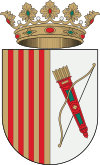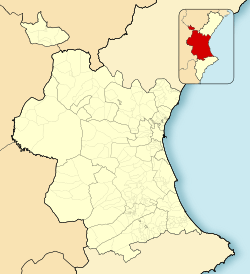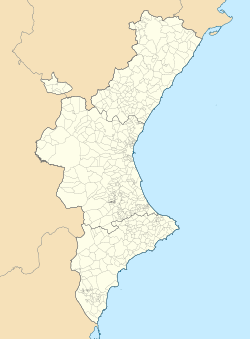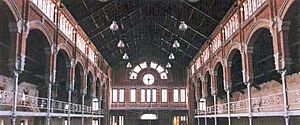Carcaixent facts for kids
Quick facts for kids
Carcaixent
|
|||
|---|---|---|---|
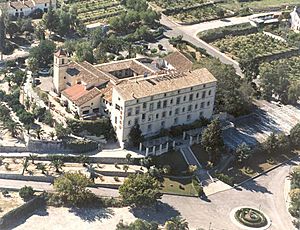 |
|||
|
|||
| Country | |||
| Autonomous community | |||
| Province | Valencia | ||
| Comarca | Ribera Alta | ||
| Judicial district | Alzira | ||
| Area | |||
| • Total | 59.3 km2 (22.9 sq mi) | ||
| Elevation | 21 m (69 ft) | ||
| Population | |||
| • Total | 20,424 | ||
| • Density | 344.42/km2 (892.0/sq mi) | ||
| Demonym(s) | Carcaixentí, carcaixentina | ||
| Time zone | UTC+1 (CET) | ||
| • Summer (DST) | UTC+2 (CEST) | ||
| Postal code |
46740
|
||
| Official language(s) | Valencian and Spanish | ||
Carcaixent is a town in eastern Spain, located in the province of Valencia. About 20,000 people live there. Its history goes back a long time, even to prehistoric times when ancient Iberian and Roman people lived there. Carcaixent is about 40 kilometers south of Valencia, which is the main city of the province. It is famous for being where orange farming really took off, especially in the 1800s and 1900s. Today, most people work in farming or in service jobs.
Contents
Carcaixent's History
People have lived in the Carcaixent area since the Neolithic Age, and later, Iberian and Roman people settled here. The town itself started as a Muslim farmhouse. In 1576, King Philip II gave Carcaixent the special title of "University." Later, he made it a "Villa Real," which gave it the right to vote in the Courts of Valencia.
In the 1700s, Carcaixent grew a lot, both in people and money. This was thanks to a strong silk industry. However, by the late 1700s and early 1800s, farmers started growing orange trees instead of other crops. Carcaixent became an official city in 1916.
Cool Places to See
Carcaixent has some interesting historical buildings and natural spots.
Monastery of Aguas Vivas
This monastery was built in the 1500s and 1600s. It has a cloister, a church, a sacristy, and a bell tower. The church was built in 1724. It's a strong building with a central courtyard.
Hermitage of Sant Roc de Ternils
This old chapel was first built for St. Bartholomew. It was designed to hold many people. It has a single long room with chapels between the support walls. The roof is made of Arabic tiles. Inside, you can see simple paintings with geometric shapes and stripes on the ceiling beams.
Magatzem de Ribera
This is a large warehouse built in the early 1900s. It was made to store oranges. The town bought it in 1989. These types of buildings needed lots of open space inside for machinery. They were also built in good locations for transport. This warehouse was likely built between 1900 and 1910.
Hort de Soriano
Hort de Soriano is a beautiful traditional farm area in Carcaixent. It's over 100 years old and helped start orange farming in the area. The town bought it in 1991 to protect it and promote tourism. It's now a municipal natural site. You can find a picnic area, a play area, and a sports area here. There are also signs about four walking routes and a nature center for learning about the environment.
Carcaixent: Birthplace of the Orange
The orange fruit came to Spain and then spread to the rest of the world through Valencia. In Greek mythology, there's a story about the Garden of the Hesperides where golden apples grew. Some people later thought these "golden apples" might have actually been oranges, which were unknown in Europe before the Middle Ages.
The word "orange" likely comes from the Sanskrit word narang and the Persian word narensh. When Arabs brought orange farming to the Iberian Peninsula, they called the fruits naranjah. The Region of Valencia kept growing oranges after the Arab period. There are records of orange trees in Valencia city from the 1300s. For example, Valencia's 1400s Silk Exchange market, (La Llotja de la Seda), which is a UNESCO World Heritage Site, has an Orange Courtyard. The first records of large orange farms are from the 1700s.
How Oranges Grew in Carcaixent
According to history, in 1781, a priest named Vicente Monzó and two friends, Carlo Maseres and Jacinto Bodí, planted the first orange groves in Carcaixent. The trees grew very well because of the warm Mediterranean climate and the rich soil. They also benefited from the Júcar River's water, which was spread through many irrigation channels across the Ribera Alta region.
In the early 1800s, orange trees slowly replaced other crops like rice, cereal, and mulberries. Oranges became the main crop in Carcaixent. Large-scale orange exports began in this century. This was helped by the arrival of the railway in 1853, which connected Carcaixent to cities like Valencia, Xàtiva, and Alzira. A railway line from Carcaixent to Gandía and Dénia opened in 1864 and ran until the early 1970s. This Carcaixent-Dénia line was one of the oldest narrow rail tracks in mainland Spain.
The Orange Route
Carcaixent has created an "Orange Route" to teach visitors about its important history with oranges. This project tells the story of the fruit, from its origins to Carcaixent's role as the place where orange farming truly began. Visitors learn about priest Monzó's first orange trees and see different types of orange warehouses from the past and present. The route also explains how oranges have been handled and sold from the late 1700s until today.
Images for kids
See also
 In Spanish: Carcagente para niños
In Spanish: Carcagente para niños



